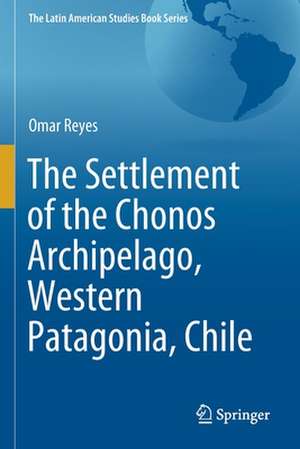The Settlement of the Chonos Archipelago, Western Patagonia, Chile: The Latin American Studies Book Series
Autor Omar Reyesen Limba Engleză Paperback – 21 oct 2021
Din seria The Latin American Studies Book Series
- 18%
 Preț: 726.85 lei
Preț: 726.85 lei - 18%
 Preț: 793.14 lei
Preț: 793.14 lei -
 Preț: 392.97 lei
Preț: 392.97 lei - 20%
 Preț: 589.21 lei
Preț: 589.21 lei - 18%
 Preț: 891.02 lei
Preț: 891.02 lei -
 Preț: 396.02 lei
Preț: 396.02 lei - 15%
 Preț: 647.40 lei
Preț: 647.40 lei - 18%
 Preț: 1018.37 lei
Preț: 1018.37 lei - 18%
 Preț: 897.65 lei
Preț: 897.65 lei - 15%
 Preț: 526.50 lei
Preț: 526.50 lei - 18%
 Preț: 748.46 lei
Preț: 748.46 lei - 18%
 Preț: 943.43 lei
Preț: 943.43 lei - 18%
 Preț: 1008.12 lei
Preț: 1008.12 lei - 15%
 Preț: 653.14 lei
Preț: 653.14 lei - 5%
 Preț: 847.00 lei
Preț: 847.00 lei -
 Preț: 414.14 lei
Preț: 414.14 lei - 15%
 Preț: 520.77 lei
Preț: 520.77 lei - 24%
 Preț: 795.92 lei
Preț: 795.92 lei - 20%
 Preț: 574.08 lei
Preț: 574.08 lei - 20%
 Preț: 560.93 lei
Preț: 560.93 lei - 24%
 Preț: 906.20 lei
Preț: 906.20 lei - 18%
 Preț: 940.39 lei
Preț: 940.39 lei - 24%
 Preț: 784.02 lei
Preț: 784.02 lei - 15%
 Preț: 470.88 lei
Preț: 470.88 lei - 24%
 Preț: 590.42 lei
Preț: 590.42 lei - 20%
 Preț: 581.65 lei
Preț: 581.65 lei - 20%
 Preț: 566.20 lei
Preț: 566.20 lei - 15%
 Preț: 635.47 lei
Preț: 635.47 lei - 24%
 Preț: 648.85 lei
Preț: 648.85 lei -
 Preț: 368.40 lei
Preț: 368.40 lei - 20%
 Preț: 574.08 lei
Preț: 574.08 lei - 15%
 Preț: 586.88 lei
Preț: 586.88 lei - 24%
 Preț: 794.73 lei
Preț: 794.73 lei - 24%
 Preț: 633.47 lei
Preț: 633.47 lei
Preț: 890.23 lei
Preț vechi: 1085.65 lei
-18% Nou
Puncte Express: 1335
Preț estimativ în valută:
170.37€ • 177.21$ • 140.65£
170.37€ • 177.21$ • 140.65£
Carte tipărită la comandă
Livrare economică 14-28 aprilie
Preluare comenzi: 021 569.72.76
Specificații
ISBN-13: 9783030543280
ISBN-10: 3030543285
Ilustrații: XXXII, 267 p. 54 illus., 43 illus. in color.
Dimensiuni: 155 x 235 mm
Greutate: 0.42 kg
Ediția:1st ed. 2020
Editura: Springer International Publishing
Colecția Springer
Seria The Latin American Studies Book Series
Locul publicării:Cham, Switzerland
ISBN-10: 3030543285
Ilustrații: XXXII, 267 p. 54 illus., 43 illus. in color.
Dimensiuni: 155 x 235 mm
Greutate: 0.42 kg
Ediția:1st ed. 2020
Editura: Springer International Publishing
Colecția Springer
Seria The Latin American Studies Book Series
Locul publicării:Cham, Switzerland
Cuprins
Presentation.- Foreword.- Acknowledgements.- Chapter 1. Introduction.- Chapter 2. Study area.- Chapter 3. Background.- Chapter 4. Methodology.- Chapter 5. The archaeological record in the Chonos Archipelago.- Chapter 6. Evaluation and discussion of the evidence.- Chapter 7. Conclusion and projections.- References.
Notă biografică
Omar Reyes, associate researcher at Centro de Estudios del Hombre Austral of the Instituto de la Patagonia, Universidad de Magallanes (Punta Arenas, Chile). He holds a PhD from Universidad de Buenos Aires, Argentina. Is an archaeologist who specializes on human/environment interactions and bioarchaeology. He has a particular interest on the process of human occupation of the northern Patagonian channels and the broader adaptation to maritime lifeways of Southernmost South America. Current research projects include studying the archaeological record at the Chonos archipelago by assessing the geomorphological features that condition the location of the information of the earliest hunter-gatherers at island settings that indicate the onset of navigational techniques in the region. In Central Patagonia and elsewhere, Omar Reyes, has been studying the lifeways of bioarchaeological populations of hunter-gatherers throughout the Holocene, by integrating palaeopathological analyses andstable isotopes.
Textul de pe ultima copertă
This book describes an archaeological investigation of human occupation in the northern area of the Patagonian archipelago in the far south of South America. It is of global anthropological and archaeological interest, dealing as it does with an archipelago characterised by a maze of islands, fiords, channels, volcanoes and continental glaciers, in an area which is still very sparsely inhabited with only scattered settlements. It was one of the last parts of the continent to be populated by man, with the arrival of marine hunter-gatherer-fishers. The arrival of human beings in this area, and their subsistence strategies in varied environments, constitute a new example of man's ability to adapt over the course of his history. It is also of interest to document how humans overcome some biogeographical barriers to occupy territories, and how other kinds of barrier restrict movement and access to other regions, leaving certain human groups isolated. Two hunter-gatherer traditions, one marine and one pedestrian, with very different cultural development processes, coexisted in this part of Patagonia separated by less than 100 km of mountains, volcanoes and glaciers. There is no evidence of contact between them over their whole time sequence; on the contrary, the archaeological and bioanthropological evidence indicates two independent axes of movement: one used by canoe groups along the Pacific coast and the other by pedestrian groups in the interior of the continent east of the Andes.
Caracteristici
Of global anthropological and archaeological interest Reconstructs the cultural loss of marine groups in the archipelago Based on ecofactual, bioanthropological and contextual testimony recovered over 10 years of investigative work
